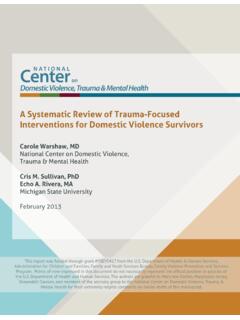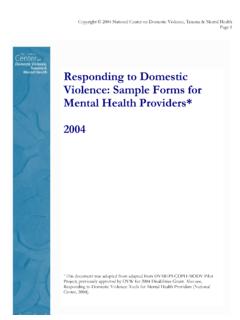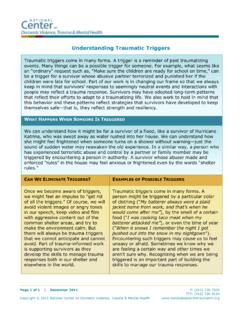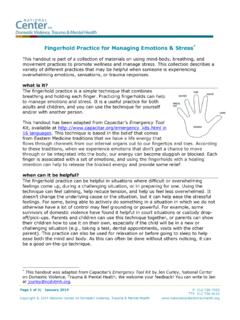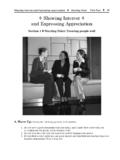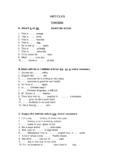Transcription of Exercises for Grounding, Emotional Regulation & …
1 Page 1 of 3 P: (312) 726-7020 TTY: (312) 726-4110 Copyright 2014 National Center on Domestic Violence, Trauma & Mental Health Exercises for grounding , Emotional Regulation & Relaxation for children and their parents Draw a Safe Place Purpose: This activity is designed to create a personally meaningful, visual representation of a safe place that the child can go to in their mind when they feel stressed. This activity promotes self-soothing both in making the drawing and then, in using the image in the future. Recommended age range: 4 years and older.
2 Instructions: Invite the child to draw a real or imaginary place that feels safe. Some children may not be able to think of a real place that is safe because of their traumatic experiences. Sometimes older children, teens, or adults may feel self-conscious about their drawing abilities. Reassure the participant(s) that this is not a drawing contest or about artistic ability, and gently encourage them to re-enter the experience. This activity can be done individually or in a small group. Some children may need prompts from the activity leader to help create this place ( elaborating on details that the child is able to articulate, such as Grandma s blanket is soft breeze in the air smell of cookies baking to give specific sights, sounds, smells, textures).
3 After the drawing is complete, invite the child to talk about the picture. Explain to the child that they can go to this space in their mind when they are feeling stressed. This can lead to a discussion about times that are stressful when going to this place in their minds might be comforting. Materials: paper, crayons, markers, or paints Bedtime Beads (Adapted from Natalie Caufield*) Purpose: This activity incorporates relaxation skills for self- Regulation . The beads incorporate both deep breathing skills that have previously been learned and practiced by the child/family and positive self-affirmations, images, and memories.
4 In creating the beads, the parent (or activity leader) and child can talk about what images the child is selecting and why they are meaningful. If done with the parent, this activity can promote increased communication and closeness. As with the Draw a Safe Place activity, some children may need help in thinking about what images, words, or memories to include on the beads. Once the beads are completed, they can be carried with the child to school, to visitation with the non-custodial parent, etc. and/or used as a bedtime ritual at home.
5 For many children, the transition to bedtime is particularly difficult, and if this becomes part of the family routine, it can help ease this transition to sleep. Recommended age range: 3 years 16 years old. * Lowenstein (ed) (2008). Assessment and Treatment Activities for Children, Adolescents, and Families. Champion Press: Toronto, Canada. Page 2 of 3 P: 312-726-7020 TTY: 312-726-4110 Copyright 2014 National Center on Domestic Violence, Trauma & Mental Health Instructions: The participant will be constructing a necklace from large and small beads and using a sturdy string that can be knotted.
6 The small beads can be all the same color (or plain wooden beads) that represent the breath beads . These are alternated with the larger beads that are decorated with positive images ( people, places, objects, animals, such as family pet, beach) or inspirational words ( love, hope, gratitude) or an image that represents a positive memory ( family trip, kicking a winning goal in soccer, etc.). For younger children, stickers may be used, and they may also need some assistance from a parent or the activity leaders in making the image(s) that they select.
7 Materials: string, small beads, larger beads, paints, markers, stickers Deep Breathing Deep breathing is a technique that can be taught to children of all ages and is beneficial by encouraging the child to focus, calm down, and relax. It is particularly helpful in that it is easy to learn, can be practiced at home, and is easy to use in any situation. Deep breathing involves teaching the child to take air in and exhale air out in a measured way while associating each breath in with becoming calm and each breath out feeling relaxed.
8 Younger children may need props and visual cues to bring attention to their breathing and to control their breath. Here are a few examples: Children can watch their belly expand as they breathe in and get smaller when they breathe out. Children can lie down and place a stuffed animal on their bellies to bring attention to their belly breaths as the animal goes up and down. Note: With this particular exercise , you will want to stop if you notice signs of increased agitation or difficulty. Children may show us that they are uncomfortable with deeper breathing (or laying on their backs) by getting up, moving away from us, changing the subject, or by not seeming to be with us in the room (in the same way that adults might).
9 The following practice, Pick a Flower, Blow a Pinwheel, has been successful with pre-school aged children and it can be fun for adults too: Imagine that you are holding a flower in one hand and a pinwheel in the other hand. Instruct the child to take a nice deep breath in through their nose (inhale) to smell the lovely flower, and hold. Then, blow out the breath through your mouth (exhale) as hard as you can, making the imaginary pinwheel move around. Repeat several times. You can teach this strategy to parents and they can demonstrate and practice this together with their children.
10 Some programs have used this deep breathing exercise as part of a larger art project, where they make flowers out of pipe cleaners and construction paper, and either make or purchase pinwheels. The children can keep these with them. Page 3 of 3 P: 312-726-7020 TTY: 312-726-4110 Copyright 2014 National Center on Domestic Violence, Trauma & Mental Health Personal Thermometer This is a technique developed by Julian Ford (1999), an expert in the field of trauma and recovery, that helps children and teens build awareness about how distressed or calm they are feeling in the moment and how in control or dysregulated they are feeling on a scale of 1-10.
